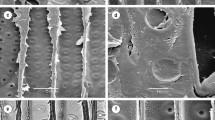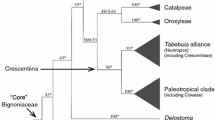Abstract
A wood anatomical study of the Mexican species ofTapirira was undertaken to uncover evidence to help clarify the systematics of the genus. Three to five individuals of each of 10 populations from throughout the range of the genus in Mexico were studied. For comparative purposes, three Central and South American species were also examined. Cluster analysis showed that the genus in Mexico can be separated into two phenetic units, represented byT. mexicana, a species widely distributed in Mexico, andT. chimalapana, a species endemic to the Isthmus of Tehuantepec. Canonical discriminant and factor analyses indicate that the quantitative wood characters most useful in distinguishing these species are wall thickness of fibers and vessels, diameter of fiber lumen, and diameter and frequency of radial canals. These species also differ in presence/absence of tannins in the fibers and color and specific gravity of the wood. The South American species,Tapirira bethanniana, T. guianensis, andT. obtusa, have wood anatomy similar to that ofT. chimalapana. The differences in the wood anatomical characters betweenT. mexicana and the other taxa suggest that the infrageneric classification ofTapirira should be reevaluated. The results of this study support the utility of sampling of populations in comparative wood anatomy.
Resumen
Con un enfoque anatómico sistemático se estudió la anatomía de la madera del géneroTapirira para aclarar su taxonomía en México. Se colectaron tres a cinco muestras en 10 poblaciones cubriendo el área de distribución del género en México, además de estudiar la madera de tres especies de Centro y Sudamérica. El análisis de agrupamiento mostró que el género en México se separa en dos unidades fenéticas que corresponden aT. mexicana, especie ampliamente distribuida en México yT. chimalapana, especie endémica del Itsmo de Tehuantepec. Los análisis canónico discriminante y de factor señalaron que los caracteres cuantitativos útiles para distinguir a las especies anatómicamente son el grosor de la pared de la fibra y el vaso, el diámetro del lumen de la fibra y el diámetro y frecuencia de los canales radiales. Además la ocurrencia de taninos en fibras, el color y gravedad específica de la madera apoyan estas conclusiones.Tapirira benthanniana, T. guianensis yT. obtusa comparten las mismas características anatómicas conT. chimalapana. Las diferencias anatómicas encontradas entreT. mexicana y las otras especies estudiadas sugieren que la clasificación infra-genérica deTapirira debe ser re-evaluada. Los resultados de este trabajo muestran la importancia de los muestreos poblacionales en los estudios de anatomía comparada de la madera.
Similar content being viewed by others
Literature Cited
Aublet, J. B. C. F. 1775. Histoire des plantes de la Guiane Françoise. Didot, Paris.
Baas, P. 1973. The wood anatomical range inIlex and its ecological and phylogenetic significance. Blumea 21: 193–258.
— 1982. Systematic, phylogenetic, and ecological wood anatomy-history and perspectives. Pages 29–53.In: P. Baas, editor. New perspectives in wood anatomy. Nijohoff/Junk, The Hague.
Bailey, I. W. 1957. The potentialities and limitations of wood anatomy in the study of the phylogeny and classification of angiosperms. J. Arnold Arbor. 38: 243–259.
Barfod, A. 1987. Anacardiaceae, Flora of Ecuador. 39(104): 9–47.
—. 1988. Inflorescence morphology of some South American Anacardiaceae and the possible phylogenetic trends. Nordic J. Bot. 8: 3–11.
— &L. B. Holm-Nielsen. 1986. Two new Anacardiaceae from Ecuador. Nordic J. Bot. 6: 423–426.
Bentham, G. &J. D. Hooker. 1862. Genera plantarum. Vol. 1, part 1. A. Black, London.
Berlyn, G. P. &J. P. Miksche. 1976. Botanical microtechnique and cytochemistry. Iowa State University Press, Ames, Iowa.
Brazier, J. D. 1968. The contribution of wood anatomy to taxonomy. Proc. Linn. Soc. London 179: 271–274.
Bridgewater, S. &P. Baas. 1982. Wood anatomy ofXanthophyllum Roxb. IAWA Bull., n.s. 3: 115–125.
Chahuan, L. &R. Dayal. 1985. Wood anatomy of Indian Albizias. IAWA Bull., n.s. 6: 213–218.
Chalk, L.. 1985. Wood anatomy, phylogeny and taxonomy. Pages 108–125.In: C. R. Metcalfe & L. Chalk, editors. Anatomy of the dicotyledons. Vol. 2. Ed. 2. Clarendon Press, Oxford.
Córdova N., Córdova C. 1985. Uso tradicional de la madera en la región de Cosautlán de Carvajal, Veracruz. B.Sc. thesis, Universidad Veracruzana, Xalapa, Veracruz, México.
Crisci, J. V. & M. F. López-Armengol. 1983. Introucción a la teoría y práctica de la taxonomía numérica. Monografía 26, Ser. Biol. OEA, Washington, DC.
Détienne, P., P. Jacquet &A. Mariaux. 1982. Manuel d'identification des bois tropicaux. 3. Guyane Française, Centre Technique Forestier Tropical, Nogent-sur-Marne.
Ehrlich, P. R. 1961. Has the biological species concept outlived its usefulness? Syst. Zool. 10: 167–176.
Engler, A. 1883. Burseraceae et Anacardiaceae. Pages 500, 536–540.In: A. C. de Candolle, editor. Monographie phanerogamarum. Vol. 4. G. Masson, Paris.
Gentry, A. H. 1982. Neotropical floristic diversity: Phytogeographical connections between Central and South America, Pleistocene climatic fluctuations, or an accident of Andean orogeny? Ann. Missouri Bot. Gard. 69: 557–593.
Graaff, N. A. van der &P. Baas. 1974. Wood anatomical variation in relation to latitude and altitude. Blumea 22: 101–121.
Grundwag, M. &E. Werker. 1976. Comparative anatomy as an aid to identification ofPistacia L. species. Israel J. Bot. 25: 152–167.
Heimsch, C. J. 1942. Comparative anatomy of the secondary xylem in the Gruinales and Terebinthales of Wettstein, with reference to taxonomic grouping. Lilloa 8: 82–198.
Holmgren, P. K., W. Keuken & E. K. Schofield. 1981. Index herbariorum. Part I. The herbaria of the world. Ed. 7. Regnum Veg. 106.
IAWA Committee. 1989. IAWA list of microscopic features for hardwood identification. IAWA Bull., n.s. 10: 219–332.
Jane, F. W. 1970. The structure of wood. Ed 2. Adam & Charles Black, London.
Kribs, D. A. 1968. Commercial foreign woods on the American market. Dover, New York.
Lavin, M. &M. Luckow. 1993. Origins and relationships of tropical North America in the context of the boreotropics hypothesis. Amer. J. Bot. 80: 1–14.
Loureiro, A. A. &P. L. Braga-Lisboa. 1979. Anatomia do lenho de seis espécies deOrmosia (Leguminosae) da Amazonia. Acta Amazon. 9: 731–746.
Mabberley, D. J. 1987. The plant-book. Cambridge University Press, Cambridge.
Mainieri, C. 1983. Manual de identificação das principais madeiras comerciais brasileiras. Instituto de Pesquisas Tecnológicas do Estado de São Paulo, São Paulo.
Manchester, S. R. 1977. Wood ofTapirira (Anacardiaceae) from the Paleogene Clarno Formation of Oregon. Rev. Palaeobot. Palynol. 23: 119–127.
Marchand, L. 1869. Révision du groupe des Anacardiacées. J.-B. Baillière et Fils, Paris.
Metcalfe, C. R. &L. Chalk. 1950. Anatomy of the dicotyledons. Vol. 1. Ed. 1. Clarendon Press, Oxford.
Miller, R. B. 1976. Wood anatomy and identification of species ofJuglans. Bot. Gaz. 137: 368–377.
—. 1981. Explanation of coding procedure. IAWA Bull., n.s. 2: 111–145.
Miranda, F. 1963. Two plants from the amber of the Simojovel, Chiapas, México area. J. Paleont. 37: 611–614.
Mitchell, J. D. 1993.Tapirira obtusa comb. nov. (Anacardiaceae). Novon 3: 66.
— &D. C. Daly. 1991Cyrtocarpa Kunth (Anacardiaceae) in South America. Ann. Missouri Bot. Gard. 78: 184–189.
Mori, S. A. &J. D. Mitchell. 1990.Tapirira bethanniana (Anacardiaceae) andEschweilera piresii subsp.viridipetala (Lecythidaceae). Mem. New York Bot. Gard. 64: 229–234.
Neff, N. A. &L. F. Marcus. 1980. A survey of multivariate methods for systematics. Privately published by the authors, New York.
Oever, L. van den, P. Baas &M. Zandee. 1981. Comparative wood anatomy ofSymplocos and latitude and altitude of provenance. IAWA Bull., n.s. 2: 3–24.
Paula, J. E. de. 1981. Estudo das estructuras internas das madeiras de dezesseis espécies da flora brasileira, visando seu aproveitamento para produção de álcool, carvão, coque e papel. Brasil Florest. 11: 23–50.
Ramanujam, C. J. R. &W. N. Stewart. 1969. Fossil woods of Taxodiaceae from Edmonton Formation (Upper Cretaceous) of Alberta. Canad. J. Bot. 47: 115–124.
Record, S. J. 1939. American woods of the family Anacardiaceae. Trop. Woods 60: 11–45.
Rury, P. M. 1985. Systematic and ecological wood anatomy of the Erythroxylaceae. IAWA Bull., n.s. 6: 365–397.
SAS Institute. 1985. SAS user's guide: Statistics. SAS Institute, Cary, North Carolina.
Sneath, P. H. &R. R. Sokal. 1973. Numerical taxonomy—The principles and practice of numerical classification. W. H. Freeman, San Francisco.
Solis del Rivero, R. 1974. Algoritmos, estrategias y modelos para métodos de agrupación. M.Sc. thesis, Colegio de Postgraduados, Chapingo, México.
Stern, W. L. 1988. Index xylariorum. Institutional wood collections of the world. 3. IAWA Bull., n.s. 9: 203–252.
Teichman, I. von 1990. Pericarp and seed coat structure inTapirira guianensis (Spondiadeae: Anacardiaceae). S. African J. Bot. 56: 435–439.
Terrazas, T. 1984. Proposición para clasificar el tamaño de algunas estructuras de la madera de angiospermas mexicanas. B. Sc. thesis, UNAM, México.
—. 1988. Anatomía sistemática de la madera del géneroTapirira (Anacardiaceae) con énfasis en México. M.Sc. thesis, Colegio de Postgraduados, Chapingo, México.
Terrazas, T. 1994. Wood anatomy of the Anacardiaceae—Ecological and phylogenetic interpretation. Ph.D. thesis, University of North Carolina at Chapel Hill.
Wannan, B. S. &C. J. Quinn. 1991. Floral structure and evolution in the Anacardiaceae. Bot. J. Linn. Soc. 107: 349–385.
Wendt, T. 1989. Las selvas de Uxpanapa, Veracruz-Oaxaca, México: Evidencia de refugios florísticos cenozoicos. Anales Inst. Biol. Univ. Nac. México, Ser. Bot. 58: 29–54.
— 1993. Composition, floristic affinities, and origins of the canopy tree flora of the Mexican Atlantic slope rain forests. Pages 595–680.In: T. P. Ramamoorthy, R. Bye, A. Lot & J. Fa, editors. Biological diversity of Mexico: Origins and distribution. Oxford University Press, New York.
— &J. D. Mitchell. 1995. A new species ofTapirira (Anacardiaceae) from the Isthmus of Tehuantepec, Mexico. Brittonia 47: 101–108.
Wheeler, E. A. 1986. Vessels per square millimetre or vessel groups per square millimetre? IAWA Bull., n.s. 7: 73–74.
Author information
Authors and Affiliations
Rights and permissions
About this article
Cite this article
Terrazas, T., Wendt, T. Systematic wood anatomy of the genus Tapirira Aublet (Anacardiaceae)— a numerical approach. Brittonia 47, 109–129 (1995). https://doi.org/10.2307/2806951
Issue Date:
DOI: https://doi.org/10.2307/2806951




